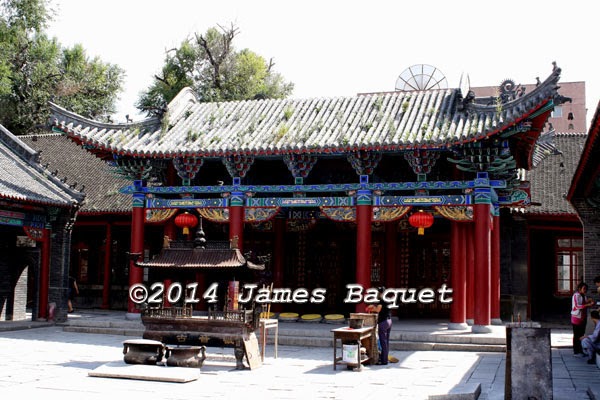(This article was published in the Shenzhen Daily on June 3, 2013.)
 |
| The figures on the ridges of most Chinese temples vary more than these at Guanyin Gucha (观音古刹) in Jilin City, Jilin (吉林, 吉林市). |
The ancient Guanyin Gucha is quite small, and seems to be seldom visited. That day, volunteers were cleaning out the sutra repository (scripture library), and using large kettles to burn unwanted papers, such as old posters and pamphlets. I wish I could have taken some away!
Most temples are named "si" (寺), originally designating a government office, and now used for Buddhist temples as well as mosques and some churches. Others may be called "an" (庵), originally a hut but now used to mean "nunnery." Or, sometimes, "yuan" (院), meaning a courtyard or enclosure, is used. But this one uses a really old word, "cha" (刹), a shortened form of "cha duo luo" (剎多羅) a transliteration of the Sanskrit word "kshetra," meaning "a field." The "Gu" in the name means "old."
Despite the Sanskrit-based name, the addition of "gu," and the fact that Jilin is one of the oldest cities in the northeast, this temple is actually young by Chinese standards, having been founded in 1753.
The temple was simple and fairly shiny, but the friendly disciples and nuns characteristically offered me fruit and tea. After a chat with them, I looked at a large statue of Guanyin, the Bodhisattva of Compassion and the temple's namesake, and then I took a taxi to the historic Jilin West Train Station for my onward journey on a slo-o-o-w train to Shenyang.
GPS Info:
- 43.84853, 126.55444
Map:
GALLERY
More pictures can be found here.
 |
| The small main hall at Guanyin Gucha, Jilin City |
 |
| Volunteers clean the scripture library |
 |
| The large entry hall at belies the modest temple behind |
 |
| The colossal Guanyin barely fits under the hipped roof of the Main Hall |
| ← Previous Article | Trip 10 Details | Next Article → |

No comments:
Post a Comment